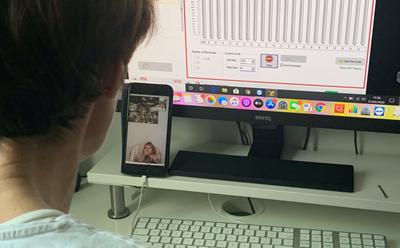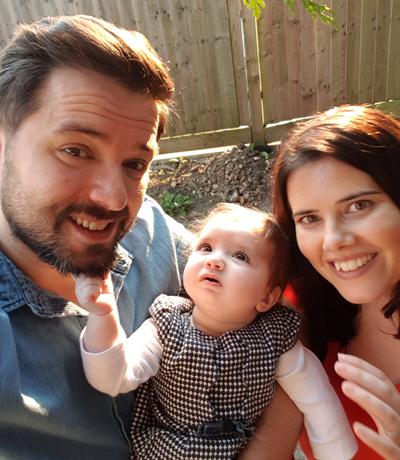Toddler given the gift of hearing using remote computer link during virus lockdown

Audiologists at the University of Southampton have conducted what is thought to be the first remote switch-on of a cochlear implant in the UK, allowing a young girl to hear for the first time.
Staff at the
University of Southampton Auditory Implant Service
(USAIS) are currently unable to see patients at their clinic due to the COVID-19 emergency measures. However, they were keen to get 18-month-old Margarida Cibrao-Roque, from Camberley in Surrey, using her new implants as soon as possible.
With some ingenious thinking, the team worked out a way to conduct their tests over the internet – connecting two computers, utilising specialist software and hardware and monitoring progress via video link.
Professor Helen Cullington
of both USAIS and the University’s
Institute of Sound and Vibration Research
(ISVR) conducted the switch-on from her home – linking remotely to Margarida’s parents’ home. She explains: “Usually we do the switch-on of a cochlear implant at our clinic at the University, but with some technical creativity and some advice from colleagues in Australia, we were able to do everything necessary over the internet. The session went really well and everyone was thrilled with the outcome.”
A cochlear implant is an electronic device that can help both children and adults with severe to profound hearing loss. Microphones on an external speech processor pick up sound, which is then transmitted as electrical signals to an internal device placed inside the inner ear during an operation. The brain interprets these signals as sound.
When an implant is switched on, levels of electrical stimulation are set by starting very slowly and gradually building up, monitoring the child or adult’s reactions all the time. The response of the hearing nerve is also measured to help set levels – especially for young children who cannot tell audiologists how loud a sound is.
Professor Cullington explains: “At switch-on, a child begins wearing their processors for the first time, and they are able to hear what is around them. However, it takes a long time to get used to this and – especially in babies and children who have never heard before – the brain has to learn to understand these sounds.”

Margarida has been deaf since birth because she has Ushers Syndrome Type One – a condition characterised by partial or total hearing loss due to abnormalities of the inner ear and vision loss that worsens over time. She was also born with a cleft palate, which can interfere with hearing. Experts at USAIS hope her new cochlear implants will, over time, help her to hear and to communicate much more easily.
Margarida’s Mum, Joana Cibrao was thrilled the switch-on could go ahead despite the COVID-19 restrictions: “The Southampton team, they were amazing. I cannot praise them enough really, the effort of the team – they were just brilliant and they made it happen.
“The possibility of Margarida calling me Mummy one day would mean the world. We will be able to speak with our daughter, to play with her – she will be able to watch TV, things that you take for granted she doesn’t have, so you know, this is a victory really.”
Margarida’s Father, Paulo Roque adds: “We are trying to give the best that we can for her and so we’ve opened a big window for Margarida now. All we need to do is take time, step by step and we will get there, definitely.”
The team at USAIS will continue to monitor Margarida’s progress and say they are committed to ensuring that all their patients have access to sound, despite the restrictions of the current pandemic. They aim to conduct several more home switch-ons in the coming weeks.
